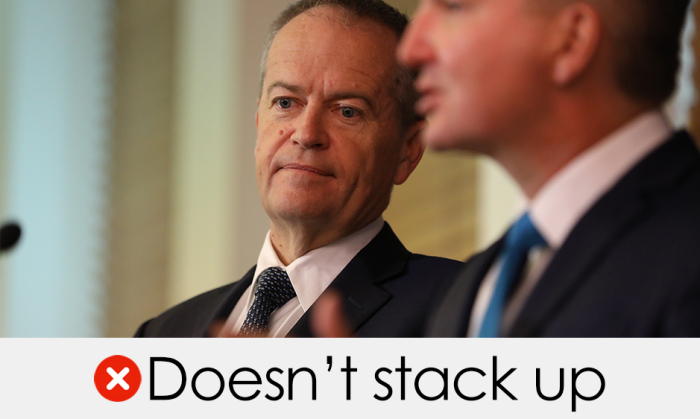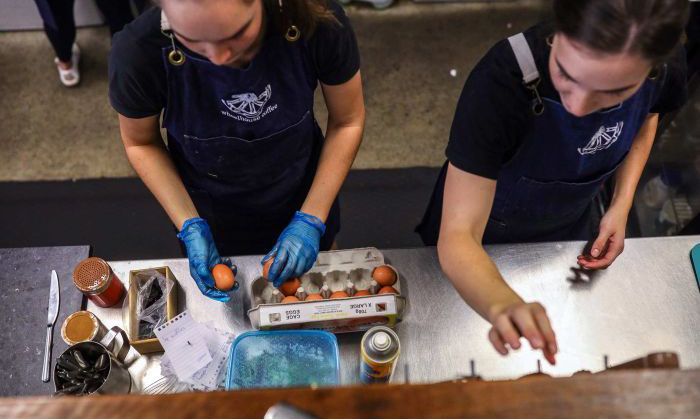How to measure wages
Experts have previously told Fact Check that the wage price index is the best way to measure changes in wages over time.
The index measures quarterly changes in wages and salaries paid by employers where the quality and quantity of labour are kept constant.
The ABS says that it is "similar to that used for other price indexes such as the Consumer Price Index", in that it measures a representative sample of jobs, much like the CPI measures a representative sample of goods and services.
The graph below shows the 12-month change from the corresponding quarter since the beginning of the WPI.
Under the Coalition Government, annual growth in the WPI slowed to as little as 1.9 per cent in the years to March 2017 and June 2017.
It has since recovered to record an annual change of 2.3 per cent in the year to December 2018, the latest figure available when Mr Shorten made his claim.
What about prices?
In making his claim, Mr Shorten referred to a number of common expenses, and surmised that "everything was going up", except wages.
Experts contacted by Fact Check agreed that inflation — that is, rising prices — needed to be taken into account when assessing whether workers were better or worse off.
The graph below shows the annual growth in the consumer price index to March 2019.
Real wages
Roger Wilkins, deputy director (research) of the Household Income and Labour Dynamics in Australia (HILDA) survey at Melbourne University, told Fact Check in an email that, "If (nominal) wages are on average going up faster than prices then, on average, workers are becoming better off."
Fact Check calculated annual real wage growth by subtracting the annual growth in the CPI from the annual growth in the WPI (see chart below).
When Mr Shorten made his claim, the latest release of the CPI was for the March quarter of 2019; the WPI data only extended as far as December, 2018.
Although the WPI has since been updated, Fact Check tests claims using the data available at the time the claim was made and thus, this analysis of real wages only extends to December, 2018.
The graph shows a varying story on real wages since the introduction of the wage price index, with falls at the turn of the century under John Howard, which coincided with the introduction of the GST, as well as at the beginning of Kevin Rudd's tenure.
The last time the growth in wages was outpaced by the growth in the consumer price index was in the year to March 2017. The growth in the WPI and CPI in the years to June 2017 and June 2018 was equal and thus real wages did not move.
Over the last two quarters for which the wage price index was available at the time of Mr Shorten's claim, real wages have recovered — in the year to September 2018 the WPI grew at a rate of 0.4 per cent greater than the CPI and in the year to December 2018, at a rate of 0.5 per cent greater than the CPI.
Overs and unders
During the first leaders' debate, Mr Shorten referred to three separate expenses which he claimed were rising — childcare (by 28 per cent), out-of-pocket costs to see the doctor (20 per cent) and the cost of seeing a specialist (40 per cent).
He also referred to wages growth "under this Government". Fact Check takes this to mean increases since the Coalition took office in September 2013.
Fact Check has previously looked at the figures regarding GP and specialist costs and found that since 2012-13 (the last full year that Labor was in Government) out-of-pocket costs to see a GP and specialists had risen by 28 per cent and 40 per cent respectively to the year 2017-18.
Fact Check also recently looked at rising child care costs, finding that they increased within the range of 23 to 28 per cent since the Coalition took office in September 2013, depending on the measure used.
Professor Wilkins said that childcare, as it is included in the CPI, measures the price paid by consumers after government subsidies, "which obviously act to reduce the price paid by consumers (but do not necessarily lead to lower price increases)."
He added that "changes to childcare subsidies introduced in July 2018 had a large impact on reducing the childcare costs for most families, especially lower-income families", and noted that the CPI includes other forms of childcare, such as before and after school care.
Fact Check has charted the percentage change from September 2013 to December 2018 in the 87 expenditure classes that make up the current CPI.
The chart illustrates that although some prices have increased dramatically, others have fallen over the same period.
Indeed, childcare increased by 23 per cent between September 2013 and December 2018, but fell 8.3 per cent in the year to December 2018. (The WPI, meanwhile, increased 2.3 per cent over the past year).
Medical and hospital services rose 31.0 per cent between September 2013 and December 2018, and were up 4.3 per cent in the year to December 2018.
Alberto Posso, of the School of Economics, Finance and Marketing at RMIT University, told Fact Check: "The CPI shows that not everything is going up; for example, communication got cheaper according to the latest ABS figures."
Indeed, telecommunications equipment and services, an expenditure class within the CPI communication grouping, fell 21.5 per cent over the period September 2017 to December 2018, and by 4.7 per cent over the year to December 2018.
Audio, visual and computing equipment recorded the largest fall over both periods — 35.4 per cent and 8.8 per cent respectively.
Falls of this magnitude would have pulled back growth in the CPI.










